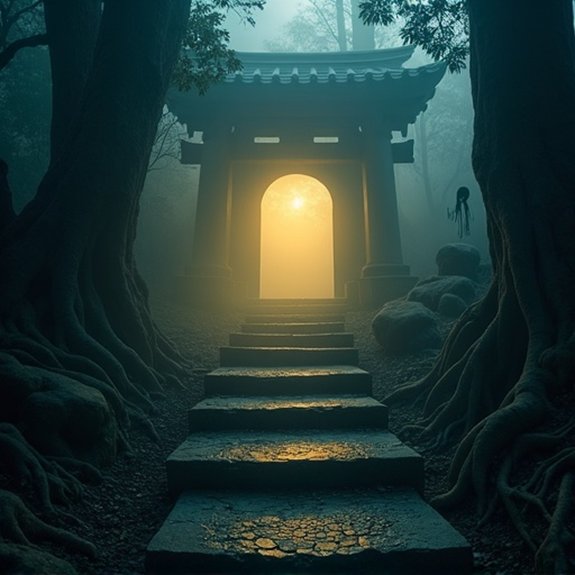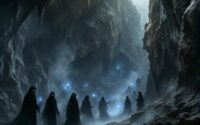The Underworld in Shinto Mythology
The ancient Japanese didn’t fear hell—they feared Yomi, a domain of decay where every soul would eventually rot. Unlike Western afterlife concepts, Shinto’s underworld doesn’t judge or punish; it simply consumes. The Kojiki’s vivid descriptions reveal a polluted wasteland that forever changed how Japan views death and purity. But what drove the living to perform elaborate rituals just to avoid its contamination? The answer lies deeper than most realize.
Introduction

When ancient Japanese people gazed into dark caves or witnessed volcanic eruptions, they imagined a shadowy territory beneath the earth where the dead dwelled and from which no living person could easily return. This realm, known as Yomi or Yomi-no-kuni, became central to Shinto mythology‘s understanding of death and the afterlife. Unlike Western concepts of hell, Yomi isn’t a place of punishment but rather a dark, polluted land where all souls go regardless of their earthly deeds. The underworld appears prominently in Japan’s oldest texts, including the Kojiki and Nihon Shoki, which describe it as separated from the living world by physical and spiritual barriers. These ancient accounts shaped how Japanese culture views death, ritual purity, and the relationship between the living and dead.
Ancient Kojiki Text References
The Kojiki, compiled in 712 CE, provides the most detailed account of Yomi in Japanese literature through its retelling of Izanagi’s descent to retrieve his deceased wife Izanami. The text describes Yomi as a dark, polluted domain separated from the living world by the Even Pass of Yomi. When Izanagi finds Izanami, she’s already eaten the underworld’s food and can’t return.
The Kojiki’s narrative establishes key underworld concepts that’ve shaped Japanese religious thought. It introduces the shikome (underworld hags), describes Yomi’s palace with its eight-pillared halls, and depicts the massive boulder Izanagi uses to seal the entrance. The text doesn’t portray Yomi as a place of judgment or punishment but rather as a territory of decay where all dead reside regardless of their earthly deeds.
Notable Cases or Sightings

How have encounters with Yomi’s territory manifested throughout Japanese history? Beyond Izanagi’s mythical journey, folk traditions describe mysterious cave systems believed to connect with the underworld. Mount Osore in Aomori Prefecture stands as Japan’s most famous gateway to Yomi, where blind mediums called itako claim they’ve communicated with the dead for centuries.
Local legends tell of travelers who’ve stumbled upon unmarked caverns emitting sulfurous fumes and heard otherworldly voices echoing from depths. The Yomotsu Hirasaka boundary stone in Shimane Prefecture marks where villagers reported seeing spirits emerge during twilight hours. Buddhist monks documented encounters at Tateyama’s “hell valleys,” where they’ve witnessed apparitions matching Yomi’s inhabitants. These accounts aren’t verified but they’ve shaped regional beliefs about death’s territory and influenced protective rituals still practiced today.
Common Theories or Explanations
While scholars debate Yomi‘s true nature, three primary interpretations dominate academic discourse about this shadowy territory. The psychological theory suggests Yomi represents humanity’s collective unconscious fears about death and decay. Proponents argue the territory’s pollution taboos reflect ancient Japanese anxieties about corpse contamination and disease.
The geographical hypothesis proposes Yomi wasn’t mythological but referenced actual burial caves or volcanic regions. Some researchers point to sulfurous hot springs and lava tubes as potential inspiration for descriptions of the underworld’s darkness and foul atmosphere.
The cosmological interpretation views Yomi as a necessary counterbalance to Takamagahara, heaven’s territory. This theory emphasizes how Yomi’s existence maintains universal equilibrium between life and death, purity and pollution. Without this shadowy territory, they argue, Shinto’s worldview would lack completeness.
Frequently Asked Questions
What Rituals or Offerings Help Appease Spirits From the Shinto Underworld?
Shinto practitioners perform misogi purification rituals, offer food and sake at shrines, burn incense, and conduct memorial services called tsuya. They’ll also place salt barriers and use protective omamori charms to ward off malevolent spirits.
How Does Yomi Compare to Underworld Concepts in Other Religions?
Yomi differs from Greek Hades and Christian Hell as it’s not a place of judgment or punishment. It’s simply where spirits go after death, resembling more a shadowy domain of decay than eternal torment.
Can Living People Visit Yomi and Return Safely According to Beliefs?
According to Shinto beliefs, living people can’t safely visit Yomi and return. Once someone enters Yomi’s domain and consumes its food, they’re bound there permanently. Even Izanagi couldn’t rescue Izanami after she’d eaten Yomi’s food.
What Happens to Souls After Death in Shinto Underworld Mythology?
Souls don’t undergo judgment or reincarnation in Yomi. They simply exist in a polluted, dark domain as shadowy spirits. They’re trapped there permanently, gradually decaying while maintaining consciousness but losing their former energy and purpose.
Are There Specific Prayers for Protection From Underworld Entities?
Yes, Shinto practitioners recite protective prayers called norito against underworld spirits. They’ll specifically use the Ōharae prayer for purification and invoke protective kami. Salt, sacred ropes (shimenawa), and omamori amulets also ward off malevolent entities.


